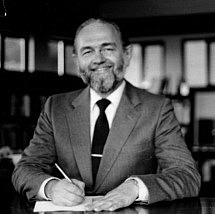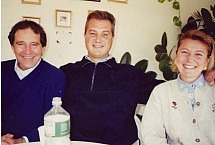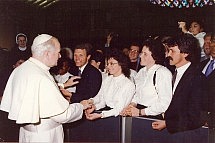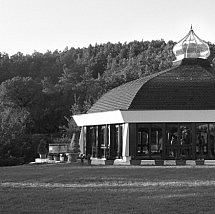The story of Ananda Europa actually begins in the 1940’s, when Kriyananda mentioned to Yogananda that there were many students writing from Europe. Master replied: ‘They have suffered very much. This teaching will help them greatly.’ After a brief pause he added: ‘Perhaps I’ll send you there some day.’
After Kriyananda had founded Ananda in California, he was often invited to speak in Italy. By 1979 he felt the time was right to ‘test the waters,’ and he sent two teachers to Rome, where they gave classes in yoga and meditation. When they reported that the spiritual climate in Italy was promising, a second exploration team was sent from Ananda Village in 1983.
Through the generosity of a friend from Milano, a small center was established in her summer villa above Lake Como. During snowy winters and cool summers (including the Chernobyl summer), we studied Italian and gave retreats for guests from Italy and northern Europe. A few European devotees came to live with the ‘early pioneers’ and were instrumental in the future growth of the work.
The pioneering group from Ananda California included Ram Smith, Dhyana
Lynn, Keshava Taylor, Kirtani Stickney, Arjuna and Shivani Lucki, Seva Wiberg, Patricia London, Lila Hoogendyk, with a long visit by Jyotish and Devi Novak. The first Italian pioneer to live with the group in Como was Claudio Gregorelli, and when the center moved down to Assisi, Helmut and Mayadevi Lauer arrived, fresh from their two years of experience at Ananda Village.
It was an inspiring and challenging time to be a part of Ananda in Europe. One challenge we didn’t expect concerned food preparation: we were cooking for people from three different countries and they each wanted the food to which they were accustomed. When we asked Swamiji his advice, he said: “If you are attentive to feeding their souls, they will not complain about the food for their bodies.” So we focused strongly on giving the teachings and it was a joy to see how they changed people’s lives.
Swamiji’s advice to us early pioneers was: practice Kriya and learn Italian. The first winter was the coldest one in Italy in 60 years. The summer villa was ill-equipped for the snows and low temperatures, and we spent a lot of time under our down comforters: we even had our planning meetings in one of the bedrooms, all covered up. This was before the technological revolution, and it took weeks and sometimes months to receive letters and packages from home. But the Masters were with us.
Finding Il Rifugio: 1986
Arjuna and I had been traveling by train down from Como to Assisi about once a month for nearly a year, looking for properties for sale or rent. It was a challenging task for newly-arrived Americans, with barely a hundred words of Italian among us. Our only confidence was the knowledge that Master and St. Francis, his ‘patron saint,’ were our real estate agents and that they would send us guides.
A taxi driver named Rino adopted us and became our chauffeur and friend. With him we saw lake-side castles, a variety of farmhouse ruins that would cost ‘but pennies’ to remodel, and several nearly-abandoned monasteries. Then one day Rino took us to a small hotel in the countryside which was about to come onto the market. Our first impression of ‘Il rifugio del Rè’ was not entirely positive, since it was small indeed, with only six guest rooms. We added it to our growing list of possibilities.
That evening the owner of the pension where we always stayed said that she knew a property for sale. The next day we emerged from her car in front of ‘Il rifugio del Rè.’ The coincidence was a strong sign, but we decided to rent an already-established cultural center for six months, to give us more time to find a permanent home.
During the fifth of these six months, a local merchant who adopted our cause phoned one day and triumphantly announced: ‘I have found your new home.’ When for the third time we emerged in front of ‘Il rifugio del Rè’ we could no longer resist the inevitable, and with the merchant’s assistance, we were able to negotiate a very favorable contract. We had barely a month to get the hotel back in working condition, and on May 5, 1987, we were welcoming our first guests. Rino, who was the first of our three angelic messengers, came to celebrate with us.
Spreading Self-realization in Europe
One of Ananda’s early mottos was: ‘The guest is God.’ In our early days in Como we used to joke, ‘The only guest is God.’ In order to spread the word
about our work, and not being yet fluent in Italian, we began to visit countries to the north of Italy where English is understood. Shivani and Arjuna gave public conferences and day-long seminars in Zurich, West Berlin (before the Wall came down), and other parts of Germany, with the help of Helmut and Maya Devi. They did programs as well in Holland, Belgium, France, and in Yugoslavia before, during and after the Balkan war. Kirtani and Anand went to Russia and found a very enthusiastic and receptive audience.
At first with translators, and then ‘flying solo,’ the early teachers gave programs in Italy, starting in the Como-Milan area and branching out to other cities in the north (Turin, Padua, Florence, Bologna, Brescia), to Rome, and eventually to the south as well, in Calabria and Sicily.
These programs attracted many people, who came as guests, and some of whom stayed on to become the first generation of European pioneers. Today there are nearly 100 people who live in and near Ananda, about 50 meditation groups and nearly 100 teachers of Ananda Yoga and meditation throughout Europe.
Ananda’s three main activities were developed simultaneously during these
formative years: a teaching center with guest facilities; economic activities to support the community; and spreading Ananda’s teachings and music throughout Europe.
Swami Kriyananda came yearly to visit the work in Italy. During his visits people from many countries came to his programs. In this way the center began to grow, and devotees came who had the desire to belong to a spiritual community. Month-long spiritual and community training programs were offered for them, and shorter programs for other guests. Many of those who came during this time have remained to guide the community’s development, including Jayadev, Bhaktan, Oliver, Graziella, Rina and Juergen.
—Shivani LuckiStarting Businesses: Ever New Cushions
When I moved to Ananda Assisi in February 1989, the guest retreat was less than two years old and had not yet become well known, as it would in future years. Very few guests came during the long, cold winter months, so the meditation cushion business was one of our major sources of income. I began helping to make cushions, and to organize work days when big orders came in (sometimes they were for as many as 1000 cushions). Our biggest clients were two companies in Germany; one always ordered maroon-colored cushions with pink lotuses appliquéd on them, and the other, catering to Zen Buddhists, always ordered black and brown cushions.
Everything was done by hand: cutting out the lotuses and cushion pieces; appliquéing the lotuses to the front of the cushions (only MayaDevi and Mary Mieth knew how to do this); pinning and stitching the pieces together; and, finally, stuffing them with kapok. It was a huge innovation when Arjuna discovered a factory near Florence with a machine that could cut hundreds of lotuses at a time.
At first, Mary Meith set up the bungalow she lived in as the cushion factory, but this became too stressful for her. By my second winter in Assisi, we were making cushions in the dining room of Il Rifugio. Money was so tight that we couldn’t turn the heat on very much, so we were working in heavy jackets and gloves with the finger tips cut out. Whenever anyone entered the dining room, a chorus of voices would call out, “Please close the door!” to avoid cold drafts coming in. It became obvious that this wasn’t working, so the factory was moved to a room on the ground floor, which is now the guest reception office. When fine spring weather came, we would move the sewing machines outside and stitch in the sunshine.
When it was time to stuff the cushions, the whole community joined in and it became a big party. This had to be done outdoors when possible, as the kapok was as light as cotton and pieces of it would float all over, filling the air. In cold weather, when the stuffing was done inside, we would have to wear masks to protect our lungs. Every cushion had to have a full kilo of kapok in it, and this was tough, as it had to be really packed in. I was able to stuff a cushion to a certain point, but then I would have to give it to a guy with stronger hands to get that last few hundred grams in. After stuffing, each cushion had to be cleaned (no small matter as the kapok would cling tenaciously to everything) and inspected for flaws, then sealed in a plastic bag.
Once the order was finished, the cushions were packed into our commercial van for transporting to Germany. Somehow, I gained the reputation of being the expert van packer, so Helmut would always ask me to help with this. There was definitely an art to getting as many cushions as possible in that van; they had to be lined up very precisely. A time that stands out in my memory was when we had to pack the van in a gale-force windstorm. I was inside the madly rocking van and Helmut was outside passing the cushions in to me, fighting the wind every second. The individually-wrapped cushions were packed in black trash bags, and as he emptied the black bags, sometimes one would get away from him; the wind would blow it away so fast, we couldn’t follow its movement; it simply disappeared.
After over 20 years, the cushion business is still thriving. Refinements have been made; the cushions are now stitched by a company near Assisi, but the workers at Inner Life still stuff them. Many of the cushions are now stuffed with buckwheat husks, which is much easier to handle than the kapok, although kapok-filled cushions are still popular. It’s inspiring to think of so many people in Europe who are meditating on cushions made at Ananda Assisi; perhaps some of the ones I made many years ago are still around.
—Gitanjali GregorelliLater, when the center outgrew its temple, a new Temple of Light
Temple of Light, Ananda Assisi
Yogananda inspired a Swiss architect with a new concept, based on open space, light, and beams soaring up a curved roof to a pointed, illuminated cupola—perhaps just the thing Yogananda had in mind when he said: “Immortalize your ideals in architecture.” Its design is unique and forward-looking, a model for the future. Temples based on its design and proportions are now being planned in other countries.
Nearly 1000 people contributed to building this temple, which was dedicated by Swami Kriyananda in September 1996, just 32 months after the work began. Thousands of people from around the world and from different spiritual traditions come to pray and meditate here, helping to make its light stronger each day.”
—Shivani LuckiNext

Please wait while you are redirected to the right page...
 Lynn, Keshava Taylor, Kirtani Stickney, Arjuna and Shivani Lucki, Seva Wiberg, Patricia London, Lila Hoogendyk, with a long visit by Jyotish and Devi Novak. The first Italian pioneer to live with the group in Como was Claudio Gregorelli, and when the center moved down to Assisi, Helmut and Mayadevi Lauer arrived, fresh from their two years of experience at Ananda Village.
Lynn, Keshava Taylor, Kirtani Stickney, Arjuna and Shivani Lucki, Seva Wiberg, Patricia London, Lila Hoogendyk, with a long visit by Jyotish and Devi Novak. The first Italian pioneer to live with the group in Como was Claudio Gregorelli, and when the center moved down to Assisi, Helmut and Mayadevi Lauer arrived, fresh from their two years of experience at Ananda Village. about our work, and not being yet fluent in Italian, we began to visit countries to the north of Italy where English is understood. Shivani and Arjuna gave public conferences and day-long seminars in Zurich, West Berlin (before the Wall came down), and other parts of Germany, with the help of Helmut and Maya Devi. They did programs as well in Holland, Belgium, France, and in Yugoslavia before, during and after the Balkan war. Kirtani and Anand went to Russia and found a very enthusiastic and receptive audience.
about our work, and not being yet fluent in Italian, we began to visit countries to the north of Italy where English is understood. Shivani and Arjuna gave public conferences and day-long seminars in Zurich, West Berlin (before the Wall came down), and other parts of Germany, with the help of Helmut and Maya Devi. They did programs as well in Holland, Belgium, France, and in Yugoslavia before, during and after the Balkan war. Kirtani and Anand went to Russia and found a very enthusiastic and receptive audience.
